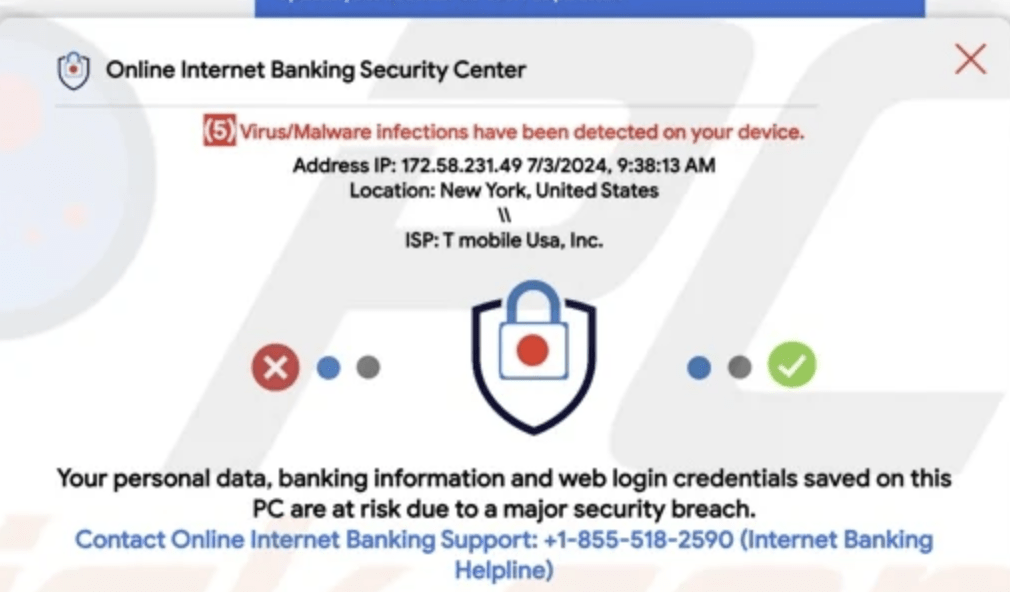The “Online Internet Banking Security Center” pop-up scam has emerged as a significant concern. This scam, often masquerading as a legitimate alert from a banking institution, aims to deceive users into divulging sensitive information or installing malicious software. Understanding the mechanics of this scam, its potential consequences, and effective removal strategies is crucial for maintaining cybersecurity.
The Actions and Consequences of the Online Internet Banking Security Center Scam
The Online Internet Banking Security Center scam typically begins with an unsolicited pop-up message appearing on a user’s screen. This message, designed to look like an urgent alert from a banking institution, may claim that the user’s account has been compromised or that immediate action is required to secure their funds. The user is then prompted to click on a link or call a provided phone number.
Upon clicking the link, several actions may occur:
- Phishing Attempts: Users are redirected to a fake banking website designed to steal login credentials and personal information.
- Malware Installation: The link may trigger the download of malware onto the user’s device. This malware can range from keyloggers and spyware to more destructive forms like ransomware.
- Tech Support Scams: Users may be connected to fraudulent tech support representatives who will request remote access to their computers, leading to further security breaches.
The consequences of falling victim to this scam can be severe, including financial loss, identity theft, and long-term damage to one’s credit score. Additionally, infected devices may become part of larger botnet operations, contributing to broader cybercriminal activities.
Contents of the Scam
Text presented in “Online Internet Banking Security Center” pop-up:
Online Internet Banking Security Center
(5) Virus/Malware infections have been detected on your device.
Address IP: –
Location: –
ISP: –
Your personal data, banking information and web login credentials saved on this PC are at risk due to a major security breach.
Contact Online Internet Banking Support: +1-855-518-2590 (Internet Banking Helpline)
Online Internet Banking
Leave Page Report an issue

Detection Names and Similar Threats
Several cybersecurity companies have identified and named variations of the malware associated with this scam. Common detection names include:
- Trojan.Win32.Generic
- PUP.Optional.FakeAlert
- HTML/FakeAlert
- Banking Trojan
Similar threats that users should be aware of include:
- Phishing Emails: Fraudulent emails mimicking legitimate entities to steal personal information.
- Fake Tech Support Calls: Scammers posing as tech support representatives to gain access to devices.
- Ransomware Attacks: Malware that encrypts files and demands payment for decryption.
Comprehensive Removal Guide
Removing the Online Internet Banking Security Center pop-up scam involves several steps to ensure complete eradication and prevent future infections.
Step 1: Disconnect from the Internet
Immediately disconnect your device from the internet to prevent further communication with the scam’s command and control servers. This action will also halt any ongoing data transmission.
Step 2: Enter Safe Mode
Restart your computer in Safe Mode to prevent the malware from running. On Windows, you can do this by:
- Pressing the
Windowskey +Rto open the Run dialog box. - Typing
msconfigand pressingEnter. - In the System Configuration window, selecting the
Boottab. - Checking the
Safe bootoption and choosingMinimal. - Clicking
OKand restarting your computer.
Step 3: Remove Suspicious Programs
Uninstall any recently installed programs that look suspicious:
- Open the Control Panel.
- Navigate to
Programs>Programs and Features. - Look for any unfamiliar programs installed around the time the pop-up appeared.
- Select and uninstall these programs.
Step 4: Clear Browser Cache and Extensions
- Open your browser and access the settings or options menu.
- Find the section for clearing browsing data (typically under
PrivacyorSecuritysettings). - Clear the cache, cookies, and browsing history.
- Check the list of installed extensions and remove any that seem suspicious or unfamiliar.
Step 5: Run a Full System Scan
Perform a full system scan using your built-in antivirus software:
- Open your antivirus program.
- Select the option for a full or complete system scan.
- Allow the scan to run and follow any prompts to remove detected threats.
Step 6: Restore Browser Settings
Reset your browser settings to default to remove any lingering traces of the scam:
- Open your browser’s settings or options menu.
- Locate the section for resetting settings (usually under
AdvancedorSystem). - Follow the prompts to reset your browser to its default state.
Best Practices for Preventing Future Infections
To protect yourself from similar threats in the future, consider the following best practices:
- Enable Multi-Factor Authentication (MFA): Add an extra layer of security to your online accounts.
- Regularly Update Software: Ensure your operating system, browsers, and applications are up-to-date with the latest security patches.
- Use Strong, Unique Passwords: Avoid reusing passwords across different accounts and use a password manager to keep track of them.
- Be Cautious with Links and Attachments: Do not click on links or download attachments from unknown or unsolicited emails.
- Monitor Financial Statements: Regularly review your bank statements and credit reports for any unauthorized transactions.
- Educate Yourself: Stay informed about common scams and how to recognize them.
By following this comprehensive guide, users can effectively remove the Online Internet Banking Security Center pop-up scam from their devices and implement preventative measures to safeguard against future cyber threats.





